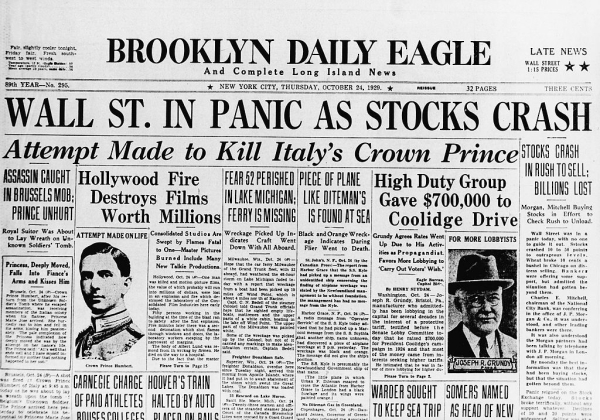This past Thursday was the 90th anniversary of Black Thursday, a day when sellers on Wall Street panicked and closed approximately 13 million shares on the NYSE … causing 5 billion in immediate losses and spurring the Great Depression, easily the worst stock market crash in US history.

With 90 years of education, technology and progress under our belts, we can look back at their mistakes assuming that it could never happen again – but could it?
The years prior to 1929 were filled with post-WW1 optimism and massive speculation. The combined net profits of 536 manufacturing and trading companies in the first six months of 1929 showed an increase of 36.6% over 1928, itself a record half-year. Rural Americans flocked to cities to take part in the excess of the Roaring Twenties. Stock prices were rising and there was massive economic growth. Like many 20 years olds, the '20s was a period where Americans felt invincible, right up until October 24th of 1929. We almost made it out of the decade.
On the day the 1929 Crash started, 11% of the Dow's value was lost by the opening bell. There was so much trading that the ticker tape reports were backed up. Traders had no idea of the true value of the stocks. Panic. Suddenly, 5 billion dollars was gone, along with optimism and trust in the system. By Black Tuesday, several stocks sat without buyers and the Dow drops another 12%. Collective confidence shattered. Psychological traumas compounded until there was widespread economic PTSD. Uncertainty spread like wildfire. Owners of businesses were unsure if they could get credit, workers were uncertain of job prospects or whether they'd get paid. As a result, consumption dropped, businesses failed, banks followed, and shortly thereafter, so did the Great Depression.
From the peak of the Dow (September 3, 1929) to the bottom of the Great Depression (July 8, 1932) the Dow lost 90% of its value.
Human Nature is Human Nature
We've since instituted many measures to protect businesses, banks, and consumers, including measures to suspend trading in periods of rapid decline (like the Securities Act of 1933 and the Securities Exchange Act of 1934). As well, we have a better understanding and tracking of economic barometers like car sales, real estate, etc.
The reality is that in various scales and timeframes human traders undergo the same issues time and time again. It only becomes a talking point when it becomes painful enough.
It shouldn't take mass unemployment and economic contraction for us to understand the dangers of speculation, the dangers of human fear, greed, and discretion, and the dangers of poor economic theory.
Human fear and greed will likely play less of a role in markets going forward. Increasingly more of trading volume is algorithmic. And increasingly more of the decisions are made with AI using more data and shorter time frames. As a result, while I expect increased volatility, I also expect increased opportunity.
Keep in mind that there is a difference between guessing and knowing … and knowing is more profitable. The corollary is: if you don't know what your edge is … you don't have one.

Here's to a great last few weeks of 2019!

Leave a Reply